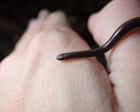
In an uplifting development for conservationists worldwide, the tiniest known snake has been rediscovered on the island of Barbados. The Barbados threadsnake, renowned for its minuscule size and slender build comparable to a piece of spaghetti, had not been seen for two decades, leading to fears that it had succumbed to extinction. However, this remarkable species has re-emerged from the shadows, offering a beacon of hope for biodiversity efforts in the region.
The rediscovery occurred in March, during an ecological survey conducted collaboratively by Barbados’s environment ministry and the global conservation organization Re:wild. Enthusiasm among the team soared when the snake was spotted under a rock in the heart of the island. This significant find not only marks the return of an elusive species but also highlights the resilience of nature and the vital importance of sustained conservation efforts.
The presence of such a delicate creature enriches the ecological tapestry of Barbados. Measuring just 10 centimeters in length, the Barbados threadsnake represents an extraordinary aspect of the island’s natural heritage. Its rediscovery serves as a poignant reminder of the intricate webs of life that thrive even in the face of adversity. The fact that this tiny snake has not disappeared entirely underscores the potential for species recovery when their habitats are protected and preserved.
Efforts to locate the snake were part of a broader initiative aimed at documenting and conserving the island’s unique flora and fauna. The ecological survey sought not only to catalog existing species but also to evaluate the health of their habitats, many of which are under threat from human activities and environmental changes. With the successful sighting of the Barbados threadsnake, conservationists find renewed motivation to continue their work with a sense of optimism and urgency.
This discovery also underscores the pivotal role local and international partnerships play in conservation endeavors. Organizations like Re:wild bring together expertise, resources, and global networks that drive initiatives toward preserving biodiversity. By fostering collaborations that cross borders, conservationists can make strides in protecting not only visible species but also those, like the threadsnake, whose existence is easy to overlook.
The return of the Barbados threadsnake is not merely an isolated success but rather a chapter in the larger narrative of island ecosystems’ resilience. Islands, with their endemic species, offer unique conservation challenges and opportunities. They act as natural laboratories where the effects of ecosystem changes can be closely studied and where tailored conservation strategies can be developed and implemented. As such, every small victory on these islands carries lessons that can be applied globally.
While the rediscovery of the world’s smallest snake brings joy, it also serves as a reminder of the ongoing challenges faced by countless threatened species. Continued research and monitoring are essential to ensuring the survival of the Barbados threadsnake and its counterparts. Protecting habitats, mitigating climate change impacts, and fostering a culture of environmental stewardship remain crucial priorities in the collective mission to safeguard our planet’s biodiversity.
In celebrating the reappearance of the Barbados threadsnake, we find renewed inspiration to cherish and protect the delicate balance of our natural world. This tiny snake’s story invites us to reflect on the hidden wonders of nature that await discovery and preservation and to commit to the conscientious stewardship of the rich biodiversity that enriches our lives.
Source: {link}
